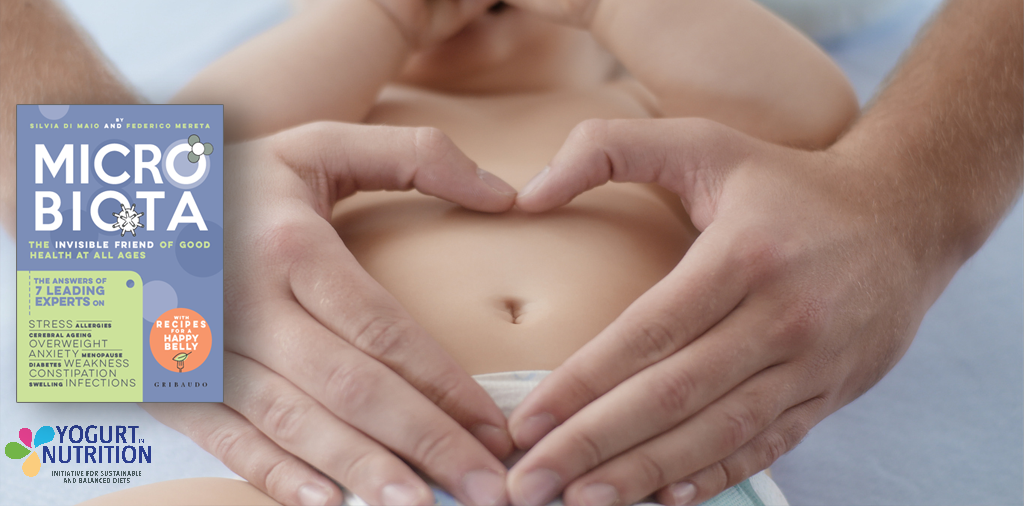The gut microbiota is characterized by a high level of microbial biodiversity. But nothing is left to chance, not even biodiversity and it begins with the first days of live.
During the 9 months in utero…
For years, it was believed that throughout pregnancy, life in utero was sterile (in the sense of being free of microorganisms). However, this may probably not be the case. Bacterial communities have in fact been observed on the placenta, in the amniotic fluid, the fetal membranes, the umbilical cord and meconium. This would suggest that microbes arrive before birth, already during gestation. However, more evidence are needed to confirm this theory of “in utero colonization”.
The birth: a key event for the gut microbiota
Newborns form their own population of gut bacteria depending on how they are born. During its passage through the birth canal, the fetus is contaminated by the microorganisms it physically encounters. In a natural birth, the newborn comes into contact with the populations of microorganisms found in the mother’s vaginal tract and faeces and will have an intestine colonized mainly by Lactobacillus and Prevotella.
When the newborns come into the world by means of caesarean section, they will encounter all the microorganisms that live on the mother’s skin and those that are somehow “introduced” by the hospital environment and staff. Babies born by caesarean section will show a less diverse microbiota, and the bacterial community will be more similar to that of the surface of the mother’s skin (Staphylococcus). Colonization by Lactobacillus will be delayed.
In both cases, immediately after birth, the intestine begins to accommodate further colonizers, mainly facultative anaerobes bacteria, which can survive and grow both in the presence and absence of oxygen.
What happen in premature baby?
In case of preterm birth, newborns are fragile, their immune system is still immature. They often suffer from respiratory and/or neurological diseases. Above all, the intestine is not yet able to face the challenges of the outside world, as it is functionally immature. When comparing full-term and premature babies, there is some difference in the microbiota itself.
Pharmaceuticals, antibiotics, intensive care and all the other factors may induce the delays and inconveniences in the forming microbiota. Anaerobic commensal microorganisms arrive later in the gut of premature babies. Higher numbers of Enterobacteriaceae, Enterococcus and other opportunistic pathogenic microorganisms have been observed in the faeces of preterm infants, which in some way “exploit” the abnormal situation to multiply.
Breastfeeding
After birth, the second main factor to influence the composition of the gut microbiota is the feeding. Some babies are exclusively breastfed, some receive infant formula, and some are fed both ways. However, it is the mother’s milk that provides the most ideal blend of components for the growth of the baby. Among them, for example, oligosaccharides, which are the third most abundant component in breastmilk after lactose and fats, and can affect the growth and function of the baby’s gut microbiota.
As long as the infant has an exclusively milk-based diet, the composition of their microbiota varies over time, becoming increasingly diverse until the baby is weaned, when it becomes more stable and complex, similar to that of the adult.
Weaning and solid foods
During weaning, the microbial diversity increases in the gut microbiota. Proteobacteria and Actinobacteria are replaced by Firmicutes and Bacteroidetes, which become the new dominant members of the microbiota. There is a relative abundance of important bacterial families such as Lachnospiraceae, Ruminococcaceae, Eubacteriaceae, Rikinellaceae, Sutterellaceae. On the contrary, we see a drop in the relative abundance of Bidiobacteriaceae, Actinomycetaceae, Veillonellaceae, Enterobacteriaceae, Lactobacilaceae, Enterococcaceae, Carnobacteriaceae, Fusobacteriaceae and Clostridiales incertae sedis XI. In short, Latin names aside, some microorganisms come and other microorganisms go.
Another substantial change that characterizes weaning is the transition from human milk to cow’s milk. Already a few days after the cessation of human milk intake, there is an increase in the relative quantities of Bacteroides, Blautia and Ruminococcus, among others, and a decrease in the relative quantities of Bifidobacterium, Lactobacillus and Enterobacteria.
As the days and weeks go by, various factors will contribute to filling the gut with new tenants, until a plateau is reached. Bacteria come and go, but the spaces are what they are, and their number will not increase by much.
In the first three years of life, any factor capable of altering the early, delicate interaction of the microbiota with the developing immune, endocrine and nervous systems will make the individual more susceptible to disease later in life. Not to mention the particular moment when new foods are introduced: this is when the child comes into contact for the first time with completely new molecules, which are bound to affect the gut microbiota as they pass through the intestine.
If want to go further and learn more, stay tuned… next posts will follow to explore the human gut microbiota.
This post is written on the basis of the book “Microbiota”.
“Microbiota” is published in english by the Danone Institute Italy and Danone Institute International. It gathers a mix of historical, anthropological and scientific concepts explaining why research on gut bacteria, from ancient texts to the most recent scientific evidence, is a sector of great interest for science. Thanks to a Q&A structure, 7 recognized experts explain several topics considering the different ages and conditions in life. The book is available in pdf and e-book format (on the Danone Institute International website)
- Learn more through our infographic on children gut’s health



